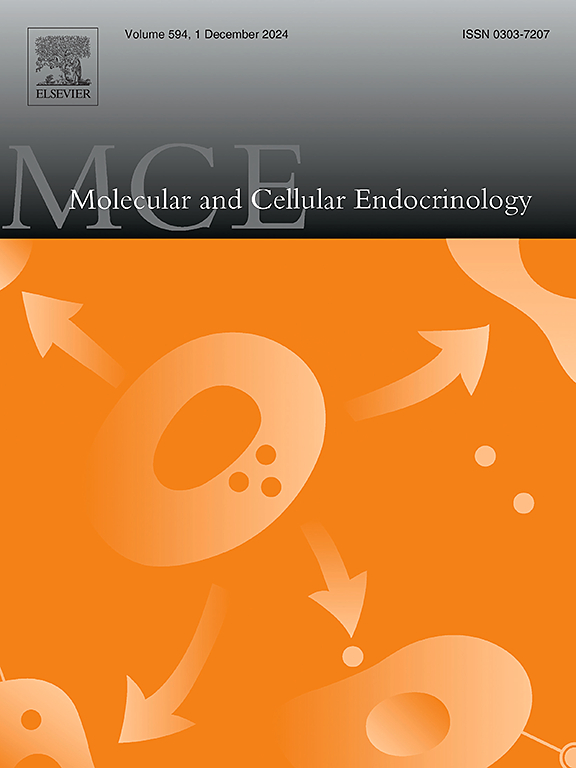人雌激素受体配体结合域识别雄烯二醇的结构比较
IF 3.6
3区 医学
Q2 CELL BIOLOGY
引用次数: 0
摘要
雌激素受体α (ERα)和β (ERβ)是配体调节的转录因子,控制着人体重要的生物过程。内源性类固醇雄烯二醇具有雌激素活性,尽管它是主要雄激素睾酮的前体。虽然雄烯二醇是这两种er的激动剂,但它对ERβ具有约3倍的选择性。此外,据报道,雄烯二醇可以以er β依赖的方式抑制中枢神经系统(CNS)的促炎反应,但主要雌激素雌二醇(E2)不能。由于没有关于ERα或ERβ与雄烯二醇相互作用的结构表征报道,ERβ选择性的基础以及这是否与雄烯二醇的抗炎作用有关尚不清楚。为了解决这些知识上的空白,我们确定了人内质网lbd (hERα和hERβ)与雄烯二醇和辅激活剂衍生肽络合的晶体结构。这表明雄烯二醇以与E2相同的方式稳定两种受体的活性构象。雄烯二醇在hERα和hERβ lbd之间的结合模式非常相似,这表明配体结合囊的非保守残基介导的范德瓦尔斯相互作用的细微差异赋予了对hERβ的选择性。最后,在这两种受体中,辅激活剂衍生的肽占据了激活功能2 (AF2)表面,正如之前的激动剂结合hER结构所观察到的那样。因此,与E2相比,雄烯二醇不会引起hERβ LBD内任何明显的结构变化,这表明雄烯二醇对中枢神经系统的hERβ依赖性抗炎作用是由其他因素介导的。本文章由计算机程序翻译,如有差异,请以英文原文为准。
Structural comparison of androstenediol recognition by the human estrogen receptor ligand binding domains
Estrogen receptors α (ERα) and β (ERβ) are ligand-regulated transcription factors that control important biological processes in humans. The endogenous steroid androstenediol possesses estrogenic activity, despite being a precursor of the primary androgen, testosterone. While androstenediol is an agonist of both ERs, it is ∼ 3-fold selective for ERβ. Additionally, it has been reported that androstenediol can repress proinflammatory responses of the central nervous system (CNS) in an ERβ-dependent manner, but the primary estrogen, estradiol (E2), cannot. As no structural characterization of the interaction between ERα or ERβ with androstenediol has been reported, the basis of ERβ selectivity, and whether this is responsible for the anti-inflammatory effects of androstenediol, remains unclear. To address these gaps in knowledge we determined crystal structures of the human ER LBDs (hERα and hERβ) complexed with androstenediol and coactivator-derived peptide. This revealed that androstenediol stabilizes the active conformation of both receptors in the same manner as E2. The binding mode of androstenediol between the hERα and hERβ LBDs is extremely similar, suggesting that subtle differences in the van der Waals interactions mediated by non-conserved residues of the ligand binding pocket confer selectivity toward hERβ. Finally, in both receptors the coactivator-derived peptide occupied the activation function 2 (AF2) surface, as observed for previous agonist-bound hER structures. Therefore, as androstenediol does not induce any distinct structural changes within the hERβ LBD compared to E2, this suggests that the hERβ-dependent anti-inflammatory effects of androstenediol on the CNS are mediated by other factors.
求助全文
通过发布文献求助,成功后即可免费获取论文全文。
去求助
来源期刊

Molecular and Cellular Endocrinology
医学-内分泌学与代谢
CiteScore
9.00
自引率
2.40%
发文量
174
审稿时长
42 days
期刊介绍:
Molecular and Cellular Endocrinology was established in 1974 to meet the demand for integrated publication on all aspects related to the genetic and biochemical effects, synthesis and secretions of extracellular signals (hormones, neurotransmitters, etc.) and to the understanding of cellular regulatory mechanisms involved in hormonal control.
 求助内容:
求助内容: 应助结果提醒方式:
应助结果提醒方式:


